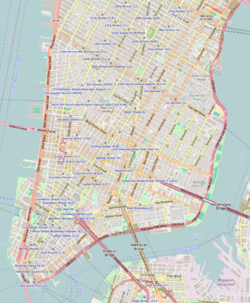| Adath Jeshurun of Jassy Synagogue (former) | |
|---|---|
 The former Adath Jeshurun of Jassy Synagogue, in 2013 | |
| Religion | |
| Affiliation | Orthodox Judaism (former) |
| Ecclesiastical or organizational status |
|
| Status | Closed |
| Location | |
| Location | 58-60 Rivington Street, Lower East Side, Manhattan, New York City, New York 10002 |
| Country | United States |
Location in Lower Manhattan | |
| Coordinates | 40°43′15″N73°59′25″W / 40.7208°N 73.9902°W |
| Architecture | |
| Architect | Emery Roth |
| Type | Synagogue |
| Style | Moorish Revival |
| Established | 1881 (as a congregation) |
| Completed | 1904 |
| Materials | Brick |
The Adath Jeshurun of Jassy Synagogue and later, the Erste Warshawer Synagogue is a former Orthodox Jewish synagogue located at 58-60 Rivington Street near Eldridge Street on the Lower East Side of Manhattan in New York City, New York, United States. The former synagogue was designed by architect Emery Roth, and completed in 1904 in the Moorish Revival style. [1]
Contents
- Synagogue history
- First Romanian-American Congregation
- Erste Warschuer Congregation
- Subsequent use
- References
The building operated as a synagogue for two different congregations until 1976 when it closed and subsequently fell into disrepair. Since 1979, the building has been used as studios and residences for local artists.
